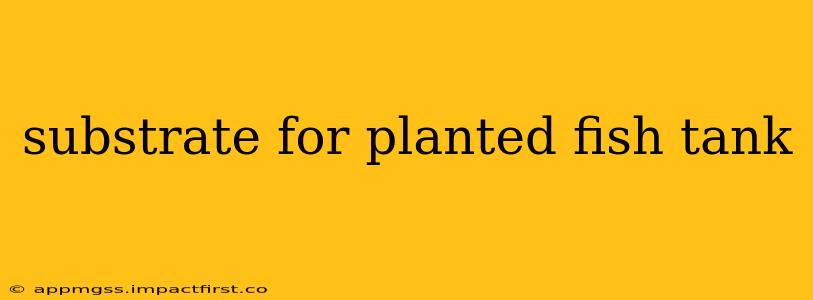Choosing the right substrate is crucial for a thriving planted aquarium. The substrate isn't just about aesthetics; it's the foundation of your aquatic ecosystem, providing essential nutrients and anchoring your plants. This guide will help you navigate the world of planted tank substrates, ensuring you select the perfect one for your specific needs and desired aquatic landscape.
What is Aquarium Substrate?
Aquarium substrate is the material that forms the bottom layer of your fish tank. Unlike simple gravel, a planted tank substrate needs to fulfill several key roles:
- Anchoring Plants: It provides a stable base for plant roots to grow and establish themselves.
- Nutrient Reservoir: Many substrates are designed to release essential nutrients vital for plant health, reducing the need for frequent liquid fertilization.
- Aesthetic Appeal: The substrate contributes significantly to the overall look of your aquarium.
Different Types of Planted Tank Substrates
Several substrate options cater to various needs and budgets:
1. Gravel and Sand
While basic gravel and sand are inexpensive and readily available, they generally lack the nutrient-holding capacity needed for demanding plants. They might be suitable for low-tech tanks with hardy species, but supplementing with liquid fertilizers will be necessary.
2. Soil-Based Substrates
These substrates incorporate elements of soil, offering a rich source of nutrients. They often provide a more natural environment for plant growth but require careful consideration due to potential water quality issues. They are particularly popular with those wanting a lush, thriving planted tank.
3. Inert Substrates (e.g., Flourite, AquaSoil)
These specifically formulated substrates are designed for planted aquariums. They provide excellent plant anchorage and, in many cases, a slow-release nutrient system. They avoid the issues associated with soil-based substrates while still supporting healthy plant growth. This is often considered the best option for beginners.
4. Specialized Substrates
Some substrates are designed for specific plant types or to address particular needs, such as enhanced nutrient delivery or improved water clarity. Researching these specific options is essential if you have particular plant requirements or aim for a specialized aquatic setup.
H2: What are the best substrates for planted tanks?
There isn't a single "best" substrate; the ideal choice depends on your tank setup, experience level, and the plants you intend to grow. For beginners, inert substrates like Flourite or similar branded options often provide the easiest path to success. Experienced hobbyists may explore soil-based substrates for enhanced nutrient delivery.
H2: How much substrate should I use in my planted tank?
The amount of substrate needed depends on the tank size and the type of substrate used. Generally, a depth of 2-4 inches is recommended. Deeper substrates offer greater nutrient retention but might increase the risk of anaerobic conditions in the lower layers.
H2: Do I need to rinse my substrate before using it?
Yes, rinsing your substrate before use is highly recommended. This removes excess dust and fines that can cloud your water and interfere with water clarity. However, be careful not to over-wash, especially with nutrient-rich substrates, as this could remove essential nutrients.
H2: How do I maintain my planted tank substrate?
Maintenance depends on the substrate type. Inert substrates generally require minimal maintenance, occasionally involving removing decaying plant matter and debris. Soil-based substrates might require more attention, potentially involving water changes and the monitoring of water parameters.
H2: Can I use aquarium substrate in a non-planted tank?
Yes, you can certainly use aquarium substrate in a non-planted tank, but simpler options like gravel or sand will often suffice and are cheaper. Many inert substrates are perfectly safe for fish only setups. Remember to consider the aesthetic impact on your tank design.
Choosing the right substrate is a significant decision when setting up a planted tank. By understanding the different types and their respective pros and cons, you can select the best option for your specific needs and create a thriving aquatic environment for your plants and fish. Remember to research your chosen substrate and follow any specific instructions for best results.
